

HTRF Human Phospho-BTK (Tyr223) Detection Kit, 10,000 Assay Points
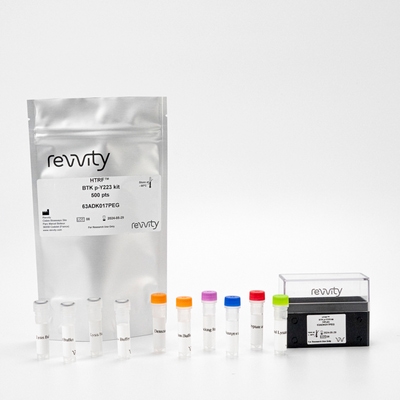

HTRF Human Phospho-BTK (Tyr223) Detection Kit, 10,000 Assay Points
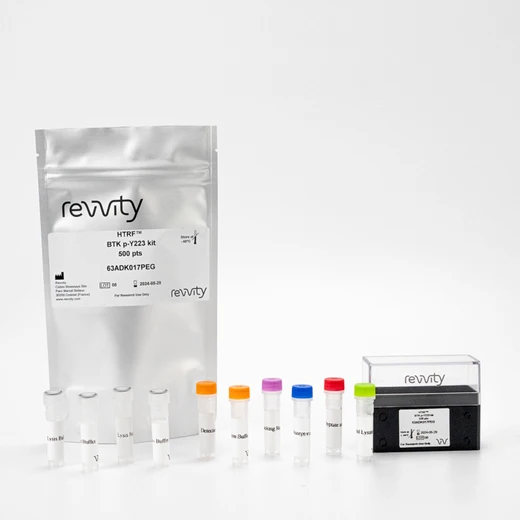


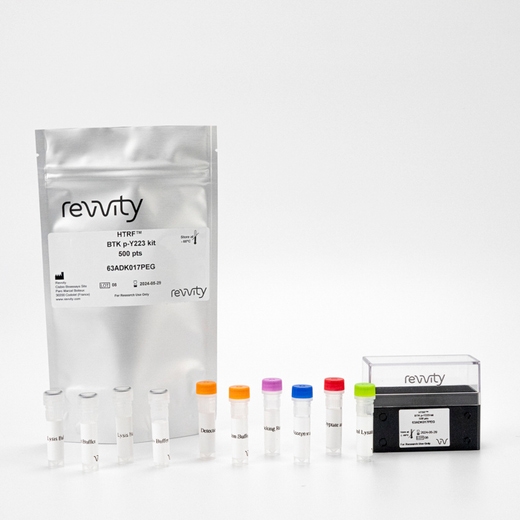


This HTRF kit enables the cell-based detection of Bruton tyrosine kinase (BTK) phosphorylation.
For research use only. Not for use in diagnostic procedures. All products to be used in accordance with applicable laws and regulations including without limitation, consumption and disposal requirements under European REACH regulations (EC 1907/2006).
| Feature | Specification |
|---|---|
| Application | Cell Signaling |
| Sample Volume | 16 µL |
This HTRF kit enables the cell-based detection of Bruton tyrosine kinase (BTK) phosphorylation.
For research use only. Not for use in diagnostic procedures. All products to be used in accordance with applicable laws and regulations including without limitation, consumption and disposal requirements under European REACH regulations (EC 1907/2006).



HTRF Human Phospho-BTK (Tyr223) Detection Kit, 10,000 Assay Points



HTRF Human Phospho-BTK (Tyr223) Detection Kit, 10,000 Assay Points



Product information
Overview
BTK is involved in the B cell receptor and the NF kappa B signaling pathways, and has an important role in primary immunodeficiency, in particular in X-linked agammaglobulinemia (XLA) disease. The phospho BTK assay enables detection of the Bruton tyrosine kinase phosphorylation on Tyrosine 223.
Specifications
| Application |
Cell Signaling
|
|---|---|
| Brand |
HTRF
|
| Detection Modality |
HTRF
|
| Lysis Buffer Compatibility |
Lysis Buffer 1
Lysis Buffer 4
Lysis Buffer 5
|
| Molecular Modification |
Phosphorylation
|
| Product Group |
Kit
|
| Sample Volume |
16 µL
|
| Shipping Conditions |
Shipped in Dry Ice
|
| Target Class |
Phosphoproteins
|
| Target Species |
Human
|
| Technology |
TR-FRET
|
| Therapeutic Area |
Oncology & Inflammation
|
| Unit Size |
10,000 Assay Points
|
Video gallery

HTRF Human Phospho-BTK (Tyr223) Detection Kit, 10,000 Assay Points

HTRF Human Phospho-BTK (Tyr223) Detection Kit, 10,000 Assay Points

How it works
Phospho-BTK (Tyr223) assay principle
The Phospho-BTK (Tyr223) assay measures BTK when phosphorylated at Tyr223. Contrary to Western Blot, the assay is entirely plate-based and does not require gels, electrophoresis or transfer. The Phospho-BTK (Tyr223) assay uses 2 labeled antibodies: one with a donor fluorophore, the other one with an acceptor. The first antibody is selected for its specific binding to the phosphorylated motif on the protein, the second for its ability to recognize the protein independent of its phosphorylation state. Protein phosphorylation enables an immune-complex formation involving both labeled antibodies and which brings the donor fluorophore into close proximity to the acceptor, thereby generating a FRET signal. Its intensity is directly proportional to the concentration of phosphorylated protein present in the sample, and provides a means of assessing the proteins phosphorylation state under a no-wash assay format.

Phospho-BTK (Tyr223) 2-plate assay protocol
The 2 plate protocol involves culturing cells in a 96-well plate before lysis then transferring lysates to a 384-well low volume detection plate before adding Phospho-BTK (Tyr223) HTRF detection reagents. This protocol enables the cells' viability and confluence to be monitored.

Phospho-BTK (Tyr223) 1-plate assay protocol
Detection of Phosphorylated BTK (Tyr223) with HTRF reagents can be performed in a single plate used for culturing, stimulation and lysis. No washing steps are required. This HTS designed protocol enables miniaturization while maintaining robust HTRF quality.

Assay validation
HTRF vs WB using phospho & total BTK assay on human K562 cells
Human erythroleukemic K562 cells were cultured for 2 days at 37°C, 5% CO2. After lysis and centrifugation, pelleted cells were resuspended in FBS-free medium treated with 100 µM pervanadate for 20 minutes. Cells were then lysed with and soluble supernatants were collected after a 10 minute centrifugation. Serial dilutions of the cell lysate were indicated the 2 HTRF assays for either phospho or total BTK detections are 16-fold more sensitive than Western Blot.
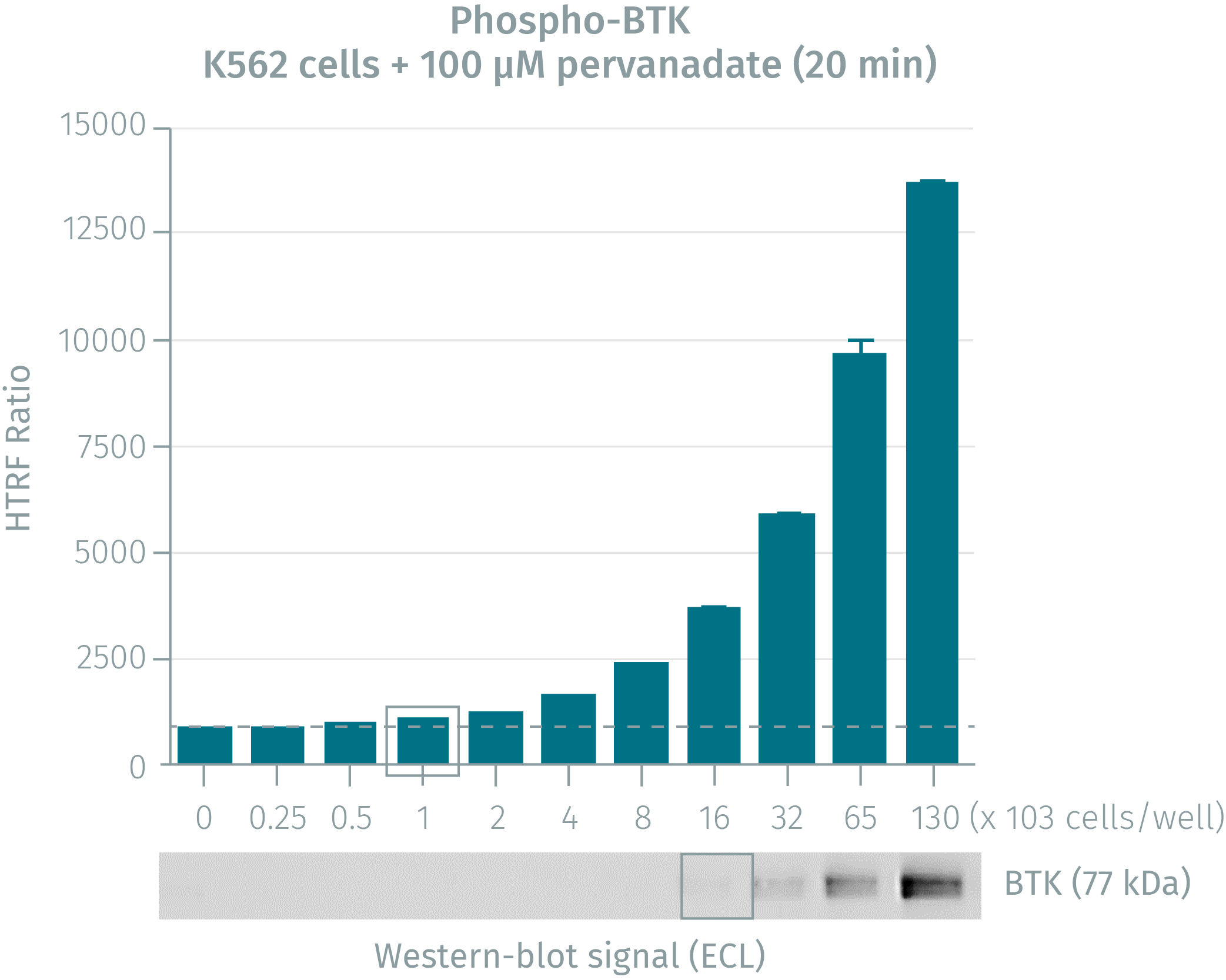
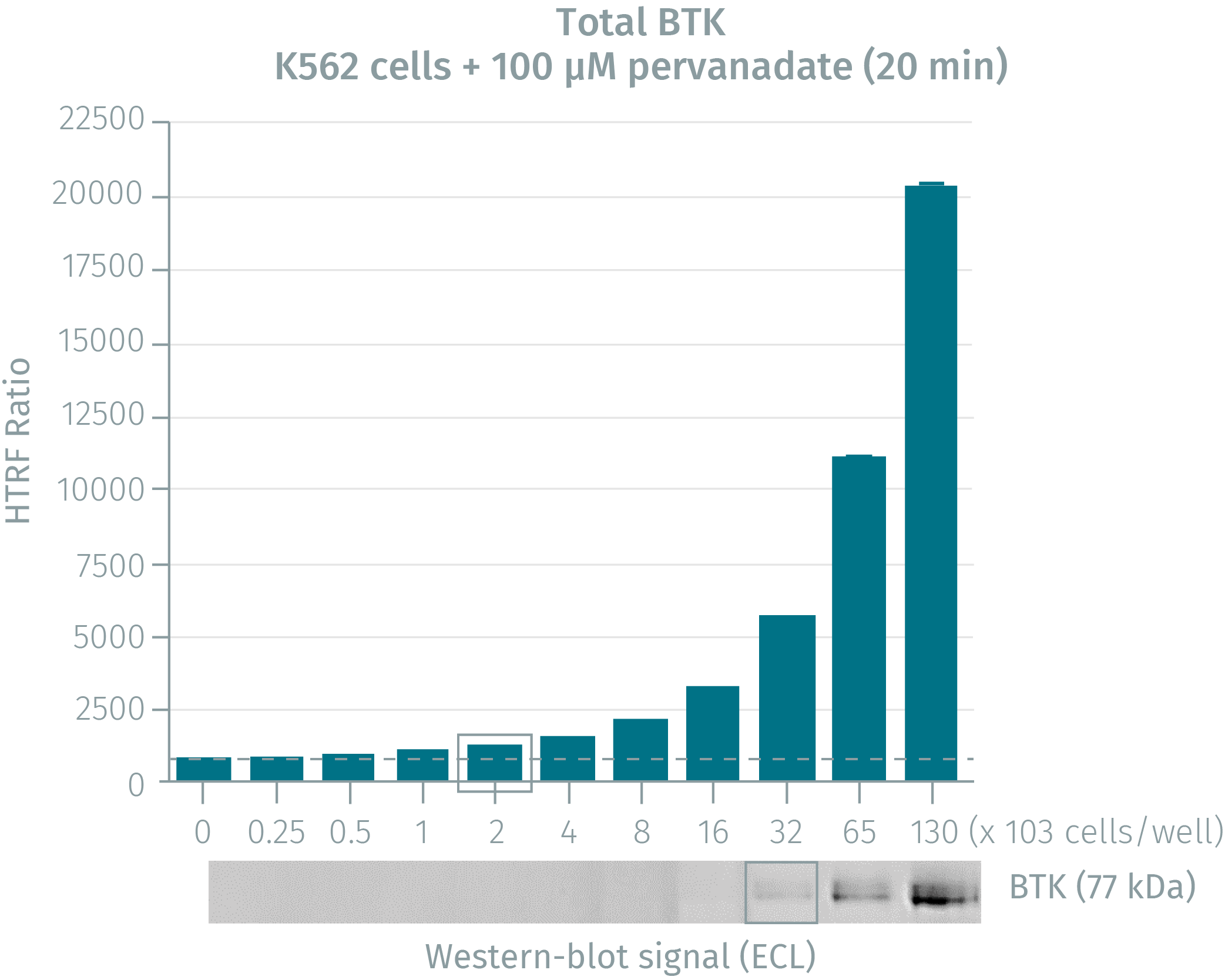
Accumulation of total & phospho-BTK in B-cell lymphoma line Raji
Using the two-plate assay protocol, human B-cell lymphoma line Raji cells were plated at 200,000 cells/ well in a half 96 well plate in 20 µl of FBS-free culture medium. After treatment for 20 minutes at 37°C (in triplicate) with 10µL of pervanadate at diffent concentrations , cells were lysed with 10 µL of supplemented lysis buffer #1 (4X) for 30min at RT under gentle shaking. 16 µL of lysate were transferred into a 384-well low volume white microplate with 4 µL of the pre-mix detection antibodies. The HTRF signal was recorded after an overnight incubation.

Inhibitory effect of Ibrutinib on the phosphorylation of BTK
Human Erythroleukemic K562 cells and Human lymphoma B-cell Raji cells were plated respectively at 100 kcells/well & 200 kcells/well under 20µl of FBS-free culture medium in a half-96 well plate. After treatment for 2 hours at 37°C with 5 µL of increasing concentrations of Ibrutinib, 5 µL of 50µM pervanadate were added for 20 min at 37°C. Cells were then lysed with 10 µL of supplemented lysis buffer #1 (4X) for 30min at RT under gentle shaking. 16 µL of lysate were transferred into a 384-well low volume white microplate with 4 µL of the pre-mix detection antibodies. The HTRF signal was recorded after an overnight incubation.

Inhibitory effect of P505-15 on the phosphorylation of BTK
Human Erythroleukemic K562 cells and Human lymphoma B-cell Raji cells were plated respectively at 100 kcells/well & 200 kcells/well under 20µl of FBS-free culture medium in a half-96 well plate. After treatment for 2 hours at 37°C with 5 µL of increasing concentrations of P505-15, 5 µL of 50µM pervanadate were added for 20 min at 37°C. Cells were then lysed with 10 µL of supplemented lysis buffer #1 (4X) for 30min at RT under gentle shaking. 16 µL of lysate were transferred into a 384-well low volume white microplate with 4 µL of the pre-mix detection antibodies. The HTRF signal was recorded after an overnight incubation.

Simplified pathway
BTK Simplified Pathway
BTK is a Cytoplasmic tyrosine kinase that's primarily expressed in B cells. It is involved in multiple signal-transduction pathways regulating survival, activation, proliferation, and differentiation of B-lineage lymphoid cells. Initiation of BCR signaling involves Lyn and Syk, part of the Src family. Lyn phosphorylates the intracellular domain of the BCR, leading to the recruitment and phosphorylation of Syk, and eventually, SLP65 phosphorylation. This leads to the recruitment and phosphorylation of BTK at Tyr551 and in turn, BTK autophosphorylates at Tyr223 for its full activation.

Resources
Are you looking for resources, click on the resource type to explore further.
This guide provides you an overview of HTRF applications in several therapeutic areas.


How can we help you?
We are here to answer your questions.






























